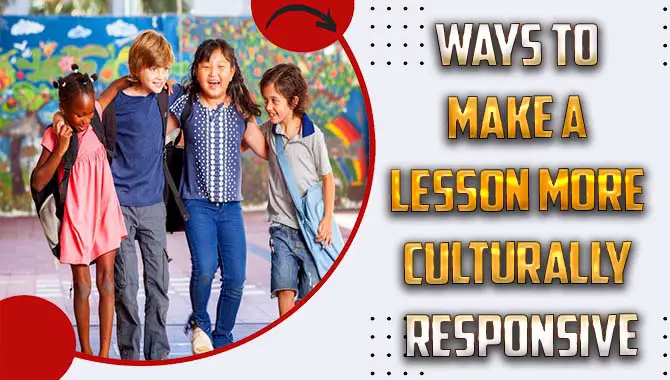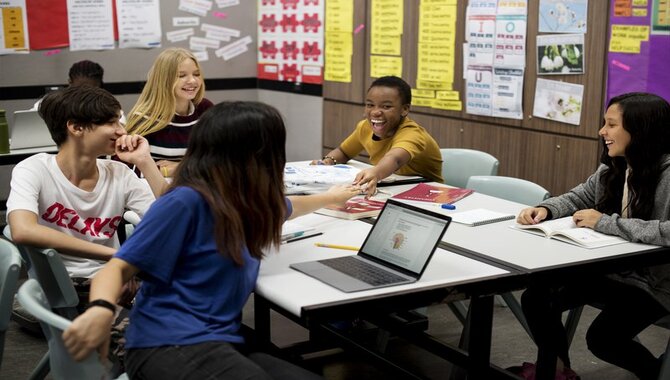Culture is a complex phenomenon that influences teaching and learning. It includes ethnicity, language background, socioeconomic background, beliefs, and more. To create culturally responsive teaching experiences, educators should be aware of students’ backgrounds and be responsive to diverse learners.
Responsive teachers can also help students develop culturally responsive thinking skills. It is important to consider how you can make your lessons culturally responsive by reflecting on your own biases and designing inclusive teaching strategies.
One of the most important things we can do as educators are to ensure that our lessons and teaching strategies are culturally responsive. Why is culturally responsive teaching so important? Because teaching students from different backgrounds means catering to their unique needs, worldviews, and experiences. This is crucial for improving students’ academic achievement and promoting equitable learning environments.

What Is Culturally Responsive Teaching?
Definitions of culturally responsive teaching vary, with some appropriately citing teaching as teaching designed to meet all students’ needs, regardless of their culture or ethnicity, and focused on learning. Others describe it as teaching that takes into account the culture and background of students in the classroom.
Still, others define it as teaching that helps students learn by using their own experiences and perspectives. Culturally responsive teaching is a way of teaching that takes into account the different cultures and backgrounds of students. This approach aims to help students learn in a way relevant to their culture and background. There are several benefits to using culturally responsive teaching methods, including:
- Students will be better prepared for college or job opportunities because they will have learned concepts in a way that applies to their own life experiences.
- Teachers will find it easier to reach all students, regardless of ethnicity, culture, or language ability.
- The learning environment will be more cooperative and collaborative, as everyone involved feels comfortable sharing their perspectives and ideas.
Strategies To Make A Lesson More Culturally Responsive
As a teacher, making your lessons relevant to students’ cultural backgrounds is important. You can use cultural references in your lesson content to make it more culturally relevant. This could include using culturally relevant vocabulary or describing cultural practices in a meaningful way to your students. Additionally, working with a local educator or community leader can help create culturally responsive lessons by providing feedback on your lesson plans and sharing their knowledge of different cultures.
By incorporating diverse cultures into the curriculum, you can help students develop an appreciation and understanding of other cultures and viewpoints. Educating yourself about the diverse cultures that exist in your community will also help you create culturally responsive lessons. Overall, ensuring your lessons are relevant to students’ cultural backgrounds is important in creating inclusive learning environments for everyone.
1.Take Time To Self-Reflect
When planning a lesson, it’s important to take time to self-reflect. This will help you identify cultural blind spots or gaps in your knowledge. By incorporating relevant materials and experiences into the class, you can ensure that your students learn from a source that intersects with their own lives and culture. By taking the time to self-reflect and incorporate culturally relevant materials into your teaching, you can better prepare students for success in today’s diverse classroom environment.
2.Create A Student-Centered Classroom
One of the ways to make a lesson culturally responsive is to create a student-centered classroom. This involves giving students a voice and allowing them to share their thoughts and experiences. It also means creating an environment where students feel comfortable asking questions and challenging teachers. In addition, classroom activities can be designed in such a way that they reflect the culture and history of the students who are participating. By creating a culturally responsive classroom, teachers can engage students in learning about different perspectives and backgrounds.
3.Rethink Your Classroom Library
Rethinking your classroom library can help make a lesson culturally responsive. The library can include materials specific to your student’s cultural and ethnic background. For example, include books that cover topics relevant to your students’ life and culture, such as language, history, or literature. You can also create lesson plans focusing on cultural topics.
For example, you could have students read a book about a famous person from their cultural heritage or explore the similarities and differences between two cultures through a social studies project. When creating these plans, it is important to remember to consider all of your students’ backgrounds and interests. Creating culturally responsive lessons ensures that all of your students feel included and empowered in the classroom.
4.Engage Students’ Families And Community
Engaging students’ families and community members in a lesson on a culturally relevant topic is important. This can help make the lesson culturally responsive. Family or community members can be asked to participate in the lesson as observers or participants. They can share their knowledge or experiences about the culture being studied.
Participatory activities, like group activities, can also help learners develop skills and gain insight into a specific culture. Engaging family and community members in cultural learning help learners build cultural competence, understand different perspectives, and develop social and emotional skills.
5.Advance Your Skills Continuously
To make your lessons culturally responsive, you must keep up with the latest teaching trends. You can do this by attending cultural events and workshops, reading news articles about relevant topics, and watching culturally relevant videos. Additionally, it helps if you prepare your lessons by incorporating culturally relevant vocabulary and resources into your teaching materials.
You will provide students with a more enriching learning experience by continuously improving your teaching skills. By staying current on the latest teaching trends and techniques, you can ensure that your students receive an engaging and culturally responsive education.
6.Reflect Consistently
It is important to consider students’ cultural context when planning a lesson. It’s crucial to be mindful of the symbols and messages conveyed through the content. For example, using culturally-appropriate teaching materials, such as images and language, in your classroom is important.
Additionally, it’s beneficial to use culturally-sensitive teaching strategies, such as visual prompts or a hands-on teaching approach. When creating your teaching plan, it’s also helpful to reflect consistently on conveying your message in culturally relevant ways. This will help ensure that your lessons are culturally responsive.
7.Encourage Students To Leverage Their Cultural Capital.

It is essential to encourage students to leverage their cultural capital to make a teaching session culturally responsive. Students should be encouraged to share their cultural experiences and perspectives in class. It can help students better understand the material being taught and allow them to engage with the learning more fully.
Additionally, providing students with opportunities to share their culture can foster a sense of community within the classroom. By leveraging their cultural capital, students will feel more connected to the material being taught and, as a result, improve their overall learning experience.
8.Make Learning Contextual.
Making a lesson culturally responsive means considering the students’ cultural context. It can be helpful to use visual aids relevant to the student’s culture. Visual aids can help students understand the concept taught by depicting relevant imagery or cultural symbols. Visual aids can also be appealing and engaging, which helps to keep students’ attention during class—ensuring that all materials used in the lesson are appropriate for the student’s age and level of understanding. Making a lesson culturally responsive will ensure that the students are engaged and learning at their best.
9.Activate Students’ Prior Knowledge.
When teaching a lesson, it’s essential to ensure that the content is culturally relevant and engaging. The best way to achieve this is by activating students’ prior knowledge and incorporating culturally relevant materials and activities into the lesson. Another effective teaching strategy is collaborative learning techniques, which encourage student input and engagement in the learning process.
You should also incorporate critical thinking and problem-solving skills into any teaching activity. It’s also helpful to incorporate cultural references into the lesson plan and make sure that it’s tailored to the student’s level of understanding. By effectively incorporating culturally relevant content into your teaching, you can ensure that you are creating engaging learning experiences for your students.
10.Design An Inclusive Curriculum
Designing an inclusive curriculum can be challenging. However, it is important to ensure that all students have the opportunity to learn and participate in the lesson. Designing an inclusive curriculum includes using culturally relevant materials, engaging students in discussion, and creating a safe and welcoming environment for all students.
It is also important to create a teaching and learning culture that supports students from different backgrounds and encourages their participation and engagement in class. Teachers can provide students with the opportunities needed to learn and grow by creating an inclusive classroom climate.
11.Account For Language Differences
When teaching a lesson, it is important to account for the different language barriers that students may have. It is essential to be aware of cultural norms and customs when teaching. For example, use visuals when teaching a lesson, such as pictures or videos, to illustrate your instruction.
Another effective strategy is Demonstration. This involves using an example from your own life to explain a topic. Using visuals, demonstrations, and analogies can help make a lesson culturally responsive and engaging for students. However, it is critical to be patient with students as they explore the material independently before providing feedback.
Conclusion
As educators, we are always striving to create learning environments that are culturally responsive for learners of all backgrounds. To make teaching culturally responsive, we must equip ourselves with a range of strategies and resources. This includes learning from student-focused teaching methods and culturally responsive teaching practices in your own and others’ contexts and building culturally responsive teaching practices into your curriculum and pedagogy.
While many factors contribute to culturally responsive teaching and learning, students’ prior knowledge, language skills, family and community support, a student-centered classroom environment, and more are critical to ensuring cultural responsiveness.
Teaching culturally responsive teaching means acknowledging students’ cultural contexts and teaching in a way that reflects their backgrounds and experiences. By creating an inclusive classroom, teaching culturally responsive teaching strategies, and using culturally responsive teaching materials, teachers can increase student engagement, improve student academic success, and help students learn in a culturally responsive manner.
Frequently Asked Questions:
Are There Any Tools Or Resources That Can Help Me With This?
When making a lesson more culturally responsive, there are several ways to go about it. Examples include using culturally relevant materials, asking open-ended questions, and incorporating interactive activities. Being conscious of the various cultural norms and values in your subject area is essential. Ss.
What Should I Look For When Selecting Books For My Class?
Selecting books to use in your class can be a daunting task, but following some simple guidelines will lead you to success. One way to make your lessons more culturally responsive is to select books written from a multicultural perspective. The author may be writing about different cultures, races, and ethnicities. This can broaden your knowledge of world literature and help you introduce new perspectives into your class.
How Do I Address Students’ Need For Knowledge About Different Cultures?
There are a few ways that you can address students’ need for more knowledge about different cultures. Some ways include using cultural references in your teaching, incorporating cultural activities into the lesson, and having students write about their experience learning about a different culture.
What Makes A Classroom Culturally Responsive?
A culturally responsive classroom strives to create a space where all students feel comfortable and respected. Responsive classrooms often incorporate cultural diversity, social justice, and climate change awareness. Responsive education also emphasizes using multiple forms of communication (verbal, nonverbal, digital). Many responsive classroom tools and resources are available online, so check them out if you’re interested in making your classroom more responsive.
What Are Some Culturally Responsive Teaching Activities?
Some culturally responsive teaching activities you may want to consider are:
1.Using stories from your culture to illustrate points being made in a lesson.
2.Incorporating songs and music into your lessons to promote cultural understanding.
3.Having students participate in hands-on activities that reflect their culture.

I’m a writer and blogger who loves to talk about entertainment, culture, and relationships. I love to share my thoughts and insights on these topics, and I’m always looking for new ways to engage with my readers. I’m also a big fan of learning new things, so I’m always exploring new areas of interest.





